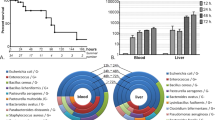Summary
The effect of retrograde intrabiliary (RI) injection ofE. coli was studied in Sprague-Dawley rats with biliary obstruction of different duration (3 days; 2, 4, and 6 weeks). By the injection of 105 colony-forming units (CFU) immediately after occlusion of the common bile duct (CBD), 15 of 18 normal rats survived without clinical signs of infection. In contrast, six of 11 animals in 3-day obstruction (P = 0.04), seven of 12 in 2-week obstruction (P = 0.02), ten of 12 in both 4-week and 6-week obstruction (P = 0.0004) died ofE. coli sepsis after injection of the same amount of bacteria. Animals with longstanding jaundice (4 and 6 weeks) were more susceptible than those with a shorter duration of jaundice (3 days and 2 weeks,P = 0.04). The results warrant the early decompression of the biliary tract in biliary obstruction.
Similar content being viewed by others
References
Alwmark A, Bengmark S, Gullstrand P, Schalen C (1981) Improvement of the splenectomized rat model for overwhelming pneumoccocal infection. Eur Surg Res 13:339–343
Aronsen KF (1961) Liver function studies during and after complete extrahepatic biliary obstruction in the dog. Acta Chir Scand [Suppl] 275:1–114
Cameron GR, Hasan M (1958) Disturbances of structure and function in the liver as the result of biliary obstruction. J Pathol Bacteriol 75:333–349
Cameron GR, Oakely CL (1932) Ligation of the common bile duct. J Pathol Bacteriol 35:769–798
Charcot MM, Gombault (1876) Note sur les altérations du foie consécutives a la ligature du canal choléoque. Arch Phys Norm Pathol 8:272–299
Chou ST, Gibson JB (1968) Experimental cholangitis and cholelithiasis. Br J Exp Pathol 49:565–573
De Vos R, Desmet VJ (1978) Morphologic changes of the junctional complex of the hepatocytes in rat liver after bile duct ligation. Br J Exp Pathol 59:220–227
Drivas G, James O, Wardle N (1976) Study of reticuloendothelial phagocytic capacity in patients with cholestasis. Br Med J 1:1568–1569
Flemma RJ, Flint LM, Osterhout S, Shingleton WW (1967) Bacteriologic studies of biliary tract infection. Ann Surg 166:563–572
Freedman LR (1963) The effect of common bile duct obstruction on susceptibility of the liver to bacterial infection. Yale J Biol Med 35:301–317
Freedman LR (1963) The relationship between bacterial infection of the hepato-biliary system and common bile duct obstruction in man. Yale J Biol Med 35:318–327
Halpern BN, Biozzi G, Nicol T, Bilbey DLJ (1957) Effect of experimental biliary obstruction on the phagocytic activity of the reticuloendothelial system. Nature 180:503–504
Hampton JC (1961) Electron-microscopic study of extrahepatic biliary obstruction in the mouse. Lab Invest 10:502–513
Holman JM, Rikkers LF (1982) Biliary obstruction and host defense failure. J Surg Res 32:208–213
Jackaman FR, Hilson GRF, Lord Smith of Marlow (1980) Bile bacteria in patients with benign bile duct stricture. Br J Surg 67:329–332
Katz S, Grosfeld JL, Gross K, Plager DA, Ross D, Rosenthal RS, Hull M, Weber TR (1984) Impaired bacterial clearance and trapping in obstructive jaundice. Ann Surg 199:14–20
Klebanoff SJ (1967) Iodination of bacteria: a bactericidal mechanism. J Exp Med 126:1063–1079
Lázár G (1972) Influence of splenectomy, partial hepatectomy and bile duct ligation on the granulopectic activity of the reticuloendothelial system. Acta Physiol Acad Sci Hung 42:287–291
Metz J, Aoki A, Merlo M, Forssmann WG (1977) Morphological alterations and functional changes of interhepatocellular junctions induced by bile duct ligation. Cell Tissue Res 182:299–310
Ronai PM, Magarey FR (1960) Experimental cholangitis following biliary obstruction. Australas Ann Med 9:289–294
Root RK, Cohen MS (1981) The microbicidal mechanisms of human neutrophils and eosinophils. Rev Infect Dis 3:565–598
Schaffner F, Popper H (1959) Morphologic studies of cholestasis. Gastroenterology 37:565–572
Scott AJ, Khan GA (1967) Origin of bacteria in bile duct bile. Lancet 2:790–792
Trams EG, Symeonidis A (1957) Morphologic and functional changes in the livers of rats after ligation or excision of the common bile duct. Am J Pathol 33:13–27
Author information
Authors and Affiliations
Rights and permissions
About this article
Cite this article
Tanaka, N., Christensen, P., Rydén, S. et al. Biliary obstruction and susceptibility to biliary sepsis in rats. Res. Exp. Med. 185, 115–119 (1985). https://doi.org/10.1007/BF01854896
Received:
Accepted:
Issue Date:
DOI: https://doi.org/10.1007/BF01854896




